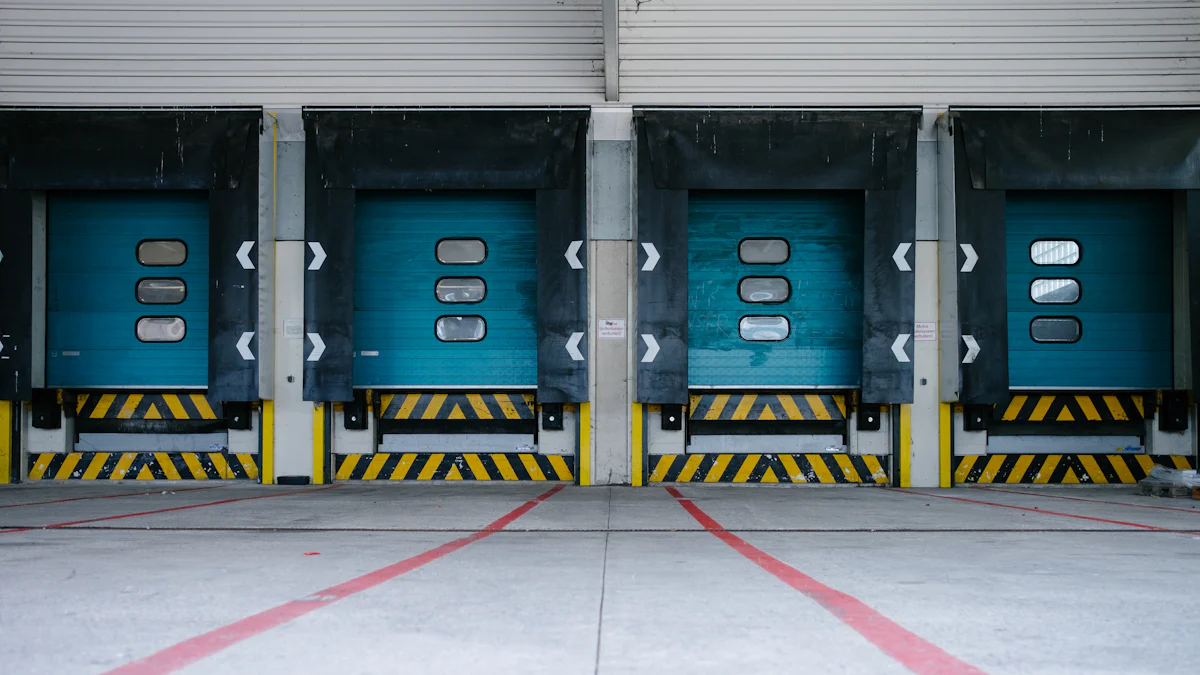
Introduction to Dock Ramps
Loading dock ramps play a crucial role in facilitating the seamless transfer of goods between different elevations, such as trucks and warehouse floors. These essential structures are designed to bridge the gap between varying heights, enabling the smooth and efficient movement of heavy loads. The choice of material for constructing loading dock ramps significantly impacts their functionality and longevity.
The Role and Importance of Loading Dock Ramps
Loading dock ramps are indispensable assets in commercial settings, where efficient logistics operations are paramount. They serve as vital connectors between delivery vehicles and warehouse facilities, allowing for the safe and swift transfer of goods. Aluminum loading dock ramps, in particular, have gained widespread recognition for their lightweight yet robust construction, making them an ideal solution for diverse loading applications.
Aluminum ramps offer a rugged standard capacity of up to 25,000 lbs, demonstrating unparalleled adaptability due to their lightweight yet durable properties. Their ability to withstand heavy traffic and harsh weather conditions makes them a practical choice for both permanent and temporary applications. Moreover, aluminum ramps provide superior traction, reducing the risk of workplace accidents during loading and unloading operations.
Overview of Common Materials Used
In addition to aluminum, other common materials used for constructing loading dock ramps include steel and wood. Each material presents unique advantages and considerations that impact their suitability for specific operational requirements. While aluminum is known for its durability, low maintenance requirements, and resistance to weather-related corrosion, steel offers exceptional strength but may require more frequent maintenance to prevent corrosion. On the other hand, wood provides a traditional aesthetic appeal but demands regular upkeep to prevent rotting and warping.
In the subsequent sections of this blog post, we will delve deeper into the advantages of aluminum loading dock ramps compared to steel and wood counterparts. By examining key factors such as weight, corrosion resistance, traction surface quality, maintenance needs, cost-effectiveness over time among others; we aim to provide comprehensive insights into why aluminum stands out as a superior choice for loading docks.
Advantages of Aluminum Loading Dock Ramps
Aluminum loading dock ramps offer a multitude of advantages that make them the preferred choice for various loading applications. Their unique properties contribute to operational efficiency, safety, and cost-effectiveness.
Lightweight and Easy to Reposition
Aluminum loading dock ramps are engineered with a focus on portability and ease of handling. Their low density and high specific mechanical properties make them remarkably lightweight compared to other materials such as steel or wood. This characteristic enables swift repositioning and adjustment according to dynamic operational needs, enhancing flexibility in managing loading processes. The ability to effortlessly relocate these ramps translates into significant time savings and streamlined workflows, ultimately impacting operational efficiency positively.
Impact on Operational Efficiency
The lightweight nature of aluminum loading dock ramps allows for quick deployment and relocation as needed, minimizing downtime during loading and unloading operations. This agility in repositioning ensures seamless transitions between different docking points, optimizing the overall logistics workflow. Furthermore, the ease of maneuvering these ramps contributes to a more efficient use of labor resources, as less effort is required for their handling compared to heavier alternatives.
Resistance to Corrosion
One of the most compelling advantages of aluminum loading dock ramps is their exceptional resistance to weather-related corrosion. Aluminum and its alloys are known for their inherent ability to withstand environmental elements without succumbing to degradation. This corrosion resistance safeguards the structural integrity of the ramps, ensuring prolonged longevity even when exposed to harsh outdoor conditions.
Longevity and Outdoor Usability
The resistance to corrosion makes aluminum loading dock ramps an ideal choice for outdoor applications where they may be subjected to varying weather conditions. The ability to maintain structural integrity over extended periods reduces the need for frequent replacements or repairs, resulting in long-term cost savings.
High-Traction Surface for Safety
Aluminum loading dock ramps feature a high-traction surface that provides exceptional grip for both wheeled equipment and personnel during loading and unloading activities. This superior traction minimizes the risk of workplace accidents caused by slippage or skidding, prioritizing safety in industrial environments.
Reducing Workplace Accidents
The high-traction surface offered by aluminum loading dock ramps significantly contributes to creating a safer working environment by mitigating the potential hazards associated with slippery surfaces. By providing reliable grip underfoot, these ramps play a pivotal role in preventing accidents and injuries related to material handling operations.
Minimal Maintenance Requirements
Aluminum loading dock ramps are renowned for their minimal maintenance requirements, setting them apart as a cost-effective and practical solution for various industrial applications. The inherent properties of aluminum and its alloys contribute to their exceptional durability and resistance to weather-related corrosion, thereby reducing the need for extensive upkeep.
Scientific Research Findings:
- Aluminum and aluminum alloys offer advantages such as low density, high specific mechanical properties, and relatively high corrosion resistance.
The low maintenance needs of aluminum loading dock ramps are attributed to their robust construction and resistance to environmental degradation. Unlike wood, which demands regular treatments to prevent rotting, or steel that requires protective coatings to mitigate corrosion, aluminum ramps require almost zero maintenance efforts. This characteristic translates into long-term cost savings and operational efficiency.
Furthermore, growing awareness about the benefits of aluminum ramps in terms of corrosion resistance and low maintenance requirements has led to an increased adoption of these structures across diverse industrial sectors. The ability of aluminum-based alloys to demonstrate promising protection against CO2 corrosion with no breakaway degradation issues further underscores their reliability in demanding environments.
To safeguard aluminum walk ramps against corrosion and wear, applying protective coatings can further enhance their longevity without imposing significant maintenance burdens. This proactive approach ensures that the ramps retain their structural integrity over extended periods, minimizing the need for frequent repairs or replacements.
Comparing Materials: Aluminum vs. Steel vs. Wood

Aluminum Loading Dock Ramps
Pros and Cons
Aluminum loading dock ramps present a range of advantages that set them apart from steel and wood counterparts. Their low maintenance requirements, quick installation, superior traction, and high resale value make them an attractive choice for various industrial applications. The virtually maintenance-free nature of aluminum ramps requires little more than an occasional hosing to rinse off mud or debris, contributing to their cost-effectiveness over time. Furthermore, the long lifespan of aluminum ramps provides a great return on investment, making them a durable and practical solution for loading docks.
Steel Loading Dock Ramps
Pros and Cons
Steel loading dock ramps offer exceptional strength and durability but come with considerations related to maintenance and lifespan. While steel ramps may have a higher initial cost compared to aluminum, they boast a longer lifespan with proper upkeep. However, their heavier weight makes them more challenging to reposition as needed, impacting operational flexibility.
Maintenance and Lifespan Considerations
Steel loading dock ramps may require more frequent maintenance to prevent corrosion, especially in outdoor environments where they are exposed to varying weather conditions. The application of protective coatings is essential to mitigate the risk of rust and degradation over time. Despite the need for ongoing maintenance efforts, steel ramps can deliver prolonged service life when properly cared for.
Wood Loading Dock Ramps
Pros and Cons
Wood loading dock ramps provide a traditional aesthetic appeal but come with inherent challenges related to maintenance and durability. While wood ramps may have a lower upfront cost compared to aluminum, they often entail higher long-term maintenance costs due to their susceptibility to rotting, warping, and decay when exposed to moisture.
Maintenance and Durability Issues
The regular upkeep required for wood loading dock ramps involves treatments to prevent rotting and deterioration caused by environmental factors such as moisture and temperature fluctuations. Additionally, the need for periodic inspections and repairs adds to the overall operational costs associated with maintaining wood ramps in optimal condition.
Expert Opinions and Industry Recommendations
Industry experts and professionals widely recognize the numerous advantages of aluminum loading dock ramps over other materials, making them a preferred choice for various loading applications. The low maintenance requirements, quick installation, superior traction, and high resale value of aluminum ramps set them apart from steel and wood counterparts. Their virtually maintenance-free nature requires little more than an occasional hosing to rinse off mud or debris, contributing to their cost-effectiveness over time. Moreover, the long lifespan of aluminum ramps provides a great return on investment.
According to industry recommendations, aluminum loading dock ramps are generally lower in maintenance and cost compared to wood ramps. They have resistance to rust and corrosion, low long-term costs, and are easy to install. Aluminum ramps also have slip-resistant decking that provides better traction than wood ramps and is much safer for those who use them.
Furthermore, experts emphasize that aluminum ramps do not require much maintenance and are extremely durable over the long term. They are easy to install, low-maintenance, durable, and easy to remove or relocate. This level of versatility cannot be achieved by their wooden counterparts.
Conclusion: The Superior Choice for Loading Docks
Summarizing the Benefits of Aluminum
In summary, aluminum loading dock ramps emerge as the superior choice for various loading applications due to their exceptional characteristics and advantages. These ramps offer a multitude of benefits that significantly impact operational efficiency, safety, and cost-effectiveness.
Aluminum ramps are renowned for their lightweight nature, making them easy to reposition and adjust according to dynamic operational needs. This portability enhances flexibility in managing loading processes, minimizing downtime during operations. Additionally, their resistance to weather-related corrosion ensures prolonged longevity even in harsh outdoor conditions, reducing the need for frequent replacements or repairs.
The high-traction surface provided by aluminum loading dock ramps contributes to creating a safer working environment by minimizing the risk of workplace accidents caused by slippage or skidding. Furthermore, their minimal maintenance requirements set them apart as a cost-effective and practical solution for various industrial applications. Unlike wood ramps that require regular treatments to prevent rotting or steel ramps demanding protective coatings to mitigate corrosion, aluminum ramps demand almost zero maintenance efforts.
Making the Right Choice for Your Needs
When considering the choice of material for loading dock ramps, it is essential to weigh the long-term benefits and practical advantages offered by aluminum against other materials such as wood. While some individuals may prefer the aesthetic appeal of wooden ramps, it is crucial to recognize that aluminum ramps surpass wood counterparts in terms of durability, low maintenance requirements, quick installation, superior traction, and resale value.
Moreover, despite initial cost considerations, investing in aluminum loading dock ramps proves to be a prudent decision due to their longevity and resistance to weather-related corrosion. The versatility and adaptability of aluminum ramps make them suitable for both permanent and temporary applications while ensuring ease of installation and relocation when needed.
In conclusion, choosing aluminum loading dock ramps aligns with the goal of optimizing operational efficiency while prioritizing safety and long-term cost-effectiveness. Their robust construction combined with minimal maintenance needs positions them as an ideal solution for diverse industrial settings where seamless material handling is paramount.
By opting for aluminum loading dock ramps over alternative materials like wood or steel, businesses can enhance their logistics workflows while ensuring a secure and reliable infrastructure for efficient goods transfer across varying elevations.









